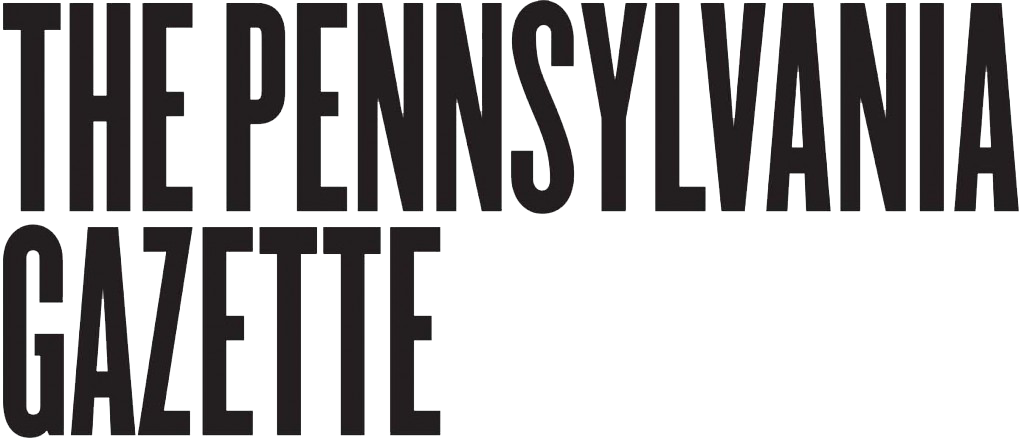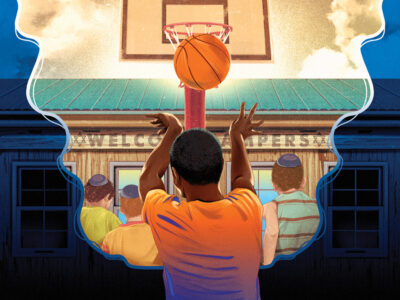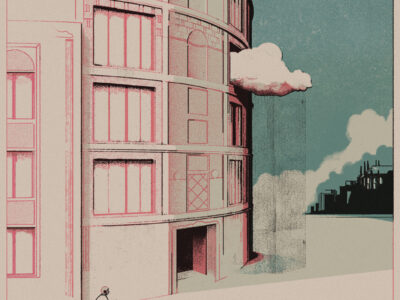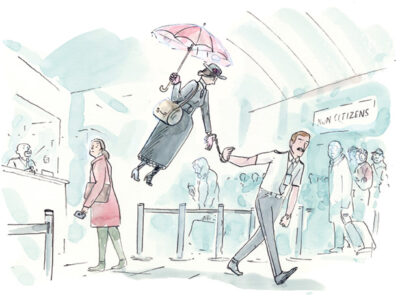
Illustration ©Graham Roumieu
How a “half-day hike” set them on a different trail.
By Jordana Horn Marinoff | Puerto Montt was nearly empty when my husband, Nathan, and I arrived there two Octobers ago. We were on our way to Chilean Patagonia—where, at the southern tip of South America, it was a lovely early spring—when we stopped at this Lake District town, whose distinctly German flavor and architecture is a legacy of its mid-19th century founders.
After eating slices of stale bundt cake in a desolate kaffeehaus, we decided that the resort town’s off-season glories lay hidden beneath its surface, and would likely be discernable only with the assistance of a knowledgeable local. So we decided to hire Enriqué, a guide in his late thirties whose features called to mind a peevish rodent.
We spent the first of our two days there on a road trip to Chiloe and its famous penguin reserve. It was an unmitigated bust. FYI: Penguins take shelter in the pouring rain, making every effort to hide in places where American tourists can’t see them. Enriqué apologized often but somewhat halfheartedly. We ate hot and delicious soup for lunch in a tiny restaurant in town, watching videotapes of local rodeos while Enriqué inhaled half a pack of cigarettes at the bar.
We resolved to spend the next day reading and strolling around town, until Enriqué offered to take us to the Osorno Volcano for a half-day, non-strenuous, lunch-included hike—“more of a long walk.” He assured us that it would rain in the early morning for an hour and then clear up. Nathan thought the plan sounded great. Now, Nathan is someone who truly enjoys hiking and outdoor activities. In contrast, I am not exactly what one would call a Hiker, and have a laissez-faire attitude towards nature: you leave me alone; I leave you alone. Nonetheless, I figured, a half-day, that’s not so long. Why not? And, after seeing pictures of Osorno in our guidebook, it was clear that this was Puerto Montt’s “not to be missed” attraction. Against the backdrop of a cerulean blue sky in the picture, Osorno looked like a majestic Southern Mount Fuji, gracefully sloping upward.
Enriqué picked us up in a van with a driver the next morning at the hotel. As instructed, we wore jeans, light windbreakers, and comfortable hiking shoes. We were surprised to find another couple in the van: Dirk and his wife Bertha, a fifty-something-year-old pair from Belgium. We rode down winding roads, at first seeing the occasional Germanic-looking church ensconced amid flowerbeds, then just tree-snarled forest as we entered the national park. We emerged from the van just as it started to rain. The driver waved and took off.
After hiking on flat ground for about 20 minutes, Enriqué noted that the trail, due to the weather, went through “a little damp spot.” Five minutes later found us fording an icy, waist-deep rushing river. To say we were surprised was an understatement. Truthfully, I would even say I was pretty pissed off. And cold and wet. But this was all part of the joy of hiking, right? Everyone else seemed to take it in stride, so I didn’t want to be the complainer.
Three hours later. We all trudged up the volcano in silence in what was now an unequivocal downpour. Not that it mattered by then. Having already crossed three waist-deep rivers to follow the trail, we couldn’t get any wetter. Enriqué had passed around chocolate milk and carrot sticks for “lunch” two hours ago, and had no more food to give. Our boots were water-resistant rather than waterproof—“resistant,” in this case, being a euphemism for “not even going to make an effort.” The view from Osorno—the allegedly gorgeous purpose of our hike—was completely obscured by the enveloping fog.
“So this is hiking,” I said to Nathan, with what I thought was a chipper smile. Response: silence.
We passed the timber line at 2,000 meters, entering an almost lunar landscape of snow patches and ice scattered among dense volcanic rock. With no trees to shelter us, the temperature dropped below freezing. We heard a screaming noise behind us. When I turned to face it, I was promptly knocked off my feet by the wind. Nathan and I held hands and followed the others through the wind and the lava field. I felt like a kite at the end of my string—a very wet, exhausted, freezing, stressed-out kite.
We descended back to the timber line, where Enriqué stopped. He looked one way, then the other. Slowly, and semi-furtively, he did it again. Suspicious.
“The trail … it seems to have washed away in the storm,” Enriqué observed in a quiet voice.
“Yeeesss … ” Dirk said slowly. “So why don’t you look at the map and figure out another way down?”
“Hmm,” Enriqué said, staring pensively off into the distance. “I should have brought a map, si.”
“You are our GUIDE! You get us down! You get us down now!” Dirk started jabbing his forefinger into Enriqué’s face and lapsed into rapid-fire Flemish. Bertha grabbed his arm and tried to calm him down.
It quickly became clear that our “guide” had not bothered to bring a compass, radio, map, forms of temporary shelter, first aid kit, matches, or extra food or water. Frenzy ensued.
“We’re soaking wet, and the temperature is dropping,” Nathan observed. “You have to get us down as soon as possible, or we could be in big trouble.”
“What can I do?” Enriqué whined. “I don’t know the way down any more than you do.”
I took some comfort in my knowledge that if we were stuck up here and it came down to cannibalism, I wouldn’t be the first to go. It was a pretty safe bet that we’d be eating Enriqué Pot Pie.
Nathan looked down the ravine ahead, and beckoned the others over.
“Water flows downhill,” Nathan pronounced. We all nodded—we had heard that. “So we should go down and follow the river until we get to the lake, at which point we’ll walk along the shore till we get to the ranger station where we’re meeting the van.”
The sides of the ravine were precipitous, at a 60-degree incline down to the river in the valley. We slid, ran, and tumbled down the rocky slant straight into the rushing river. Thanks to the rain, the waist-deep river spurted over the rocks at high speed. Hanging on to each other’s hands (Bertha, in a gesture of true and, to me, incomprehensible kindness, offered to hold Enriqué’s), we walked slowly down the river, stopping when one of us stumbled. I couldn’t think of anything except, over and over again, my new mantra: I Have Got To Get Out Of Here.
After another three hours or so, at the end of our field of vision, we saw a bluish-gray mass that made Dirk jump up and down with happiness. The lake. Nathan and I hugged each other.
“This really makes me believe in God,” he told me. “I was praying that at least you would get down off of here okay.”
“This really makes me want to have a baby.”
The words had left my mouth before I realized what I was saying. What the hell? We wanted kids, sure, but we had always figured that we had plenty of time for that.
“Absolutely,” Nathan agreed.
We made it to the van just as night fell. The driver was waiting with several park rangers, who had initially claimed it was impossible that the driver had left tourists for a hike, since the volcano was closed all day due to extremely hazardous conditions, flash flooding, and rapids that were the worst Chile had seen in two decades. When we showed up, the park ranger ripped into Enriqué. We’d apparently hiked 20 miles and had not been expected to survive. Needless to say, Enriqué did not get a tip from our group.
I still think about Osorno every now and then. I know many people who go on vacations intendingto scale mountains or hike great distances. I continue not to be one of them. Nonetheless, of all the great memories of trips I have taken, none can compare to that moment when it became clear that—at least on that particular day—we weren’t going to die. The true accomplishment was not the hike, the fear, or the aching muscles during and after, but the decision to redefine the lives we had stolen back from the edge.
Jordana Horn Marinoff C’95 L’99 is a lawyer and writer. She lives outside Philadelphia with her husband, Nathan, and their one-year-old son, Zev Gadiel, and expects their second child in April.




